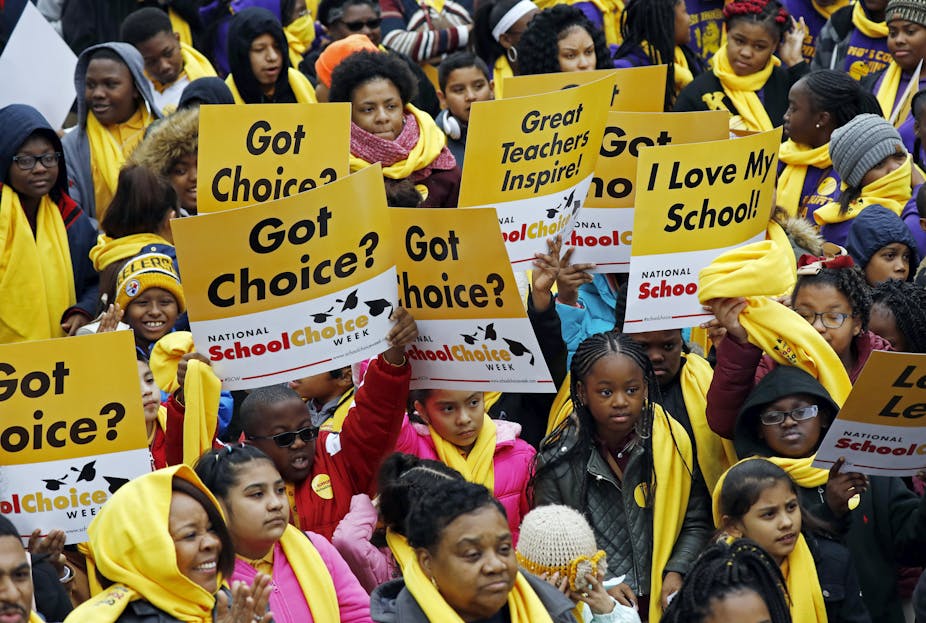The Conversation: Charter School Cap Efforts Gain Momentum
 Students, parents and teachers participate in a school choice rally in Jackson, Mississippi. Rogelio V. Solis/AP
Students, parents and teachers participate in a school choice rally in Jackson, Mississippi. Rogelio V. Solis/AP
From California to Wisconsin, efforts to stop charter school growth are gaining momentum. In the April 2019 mayoral election in Chicago, both candidates say they want to halt charter school expansion.
Financial issues lie at the core of these efforts.
Schools were hit particularly hard by the 2008 recession. Many states cut education funding. As a scholar of school finance, I would argue that charter school expansion is making this bad situation worse.
Trends in school finance
In my home state of Pennsylvania, schools watched US$1 billion disappear when former Gov. Tom Corbett, a Republican, both cut state funding and refused to replace federal stimulus funding.
A similar pattern unfolded across the country. In 2015, 29 states were still providing less money per pupil than before the recession began. In most states, state aid is designed to assist districts with high needs and low wealth. As a result, high-poverty districts were hurt the most by state cuts.
School finance scholars often consider school funding systems fair when they give additional funds to districts with the greatest needs. For instance, in conjunction with the Education Law Center of New Jersey, Bruce Baker, an education finance scholar at Rutgers University, has developed a measure of school funding fairness. In a majority of states, Baker found that funding fairness declined in the five years after the Great Recession.
Why funding disparities matter
A number of politicians, such as Education Secretary Betsy Devos, reformers, and pundits claim that education spending does not impact student learning. They are wrong.
Over and over, rigorous research has shown that money matters and that increases in funding for low-income students have a positive impact on outcomes. No matter how we define those outcomes – from scores on standardized tests to the probability a student will experience poverty as an adult – the results are consistent. Anyone who says otherwise is misinformed.
The impact of charter expansion
The details of how charter school funding is structured differs by state, and even by districts within a given state. Despite this variation, a number of studies have shown that charter school growth hurts the finances of nearby public school districts. Recent studies from New York and North Carolina have found that charter expansion negatively impacts local districts’ finances above and beyond simply losing per pupil revenue because of declining enrollments.
In Pennsylvania, the local district makes a tuition payment to the charter school enrolling each student from that district. The payment is based on per-pupil spending for similar students. For example, if a fourth grader leaves a public school in the Pittsburgh School District to attend a charter, the Pittsburgh School District is required to pay the charter school $16,805.99 – which is the average amount the district spends on a student in the district.
At first glance, it perhaps makes sense to have money follow the children. The problem is that increased charter enrollments rarely allow a district to save as much as they lose in charter tuition. As a result, without additional revenue from state governments or local taxes, districts are forced to make budget cuts and spend less on the students who remain in traditional public schools.
Consider an example. Bethlehem Area School District paid $25 million in charter school tuition payments in 2017. It was not possible to save $25 million with the students gone, however, because of the way the students were distributed across the district.
The students enrolled in charter schools came from 13 different grades in 22 different schools. Since students moving to a charter were rarely all of the students from a single school, grade or class, the district was not able to reduce staff or close classes to help cover the charter tuition payments. If next year’s third grade class goes from 28 students to 26 students in a school, district officials still need to keep that third grade class open. They cannot pay that teacher 2/28th less, heat 2/28th less of that classroom, or reduce the operation of electricity in that classroom by 2/28th.
Yet, if the class went from 28 to 26 students because two students enrolled in charters, the district needs to make tuition payments for the missing students. When those payments are repeated and distributed unevenly across schools and grades, it adds up to millions of dollars. Students move between districts all the time, but nowhere near the scale – nor with the fiscal impact – that takes place because of charter expansion. Bethlehem Area School District had 1,900 students, about 12 percent of the district’s population, enrolled in charter schools in 2017.
As Bethlehem Area School District’s business manager explained in a recent survey describing the challenges the district faces because of charter tuition payments, “there’s nothing left to cut.” Across the state, mandated costs are growing faster than the money many districts have coming in: costs for faculty and staff benefits like health insurance and pension payments, special education services and charter school tuition payments.
Charter school expansion drains dollars from local districts in other ways as well. For example, charters enroll far fewer students with characteristics that require additional financial resources, including students with disabilities and English language learners. These dynamics compound the financial difficulties for traditional public schools, which are required to educate all students.
The appeal of charter schools
Research on the academic performance of charter schools is mixed, though some perform quite well. In New York City, students in a number of well-known charters often outperform similar students in traditional public schools. It makes sense – the highest-performing charters in New York often spend $2,000 to $4,300 more per pupil than traditional public schools, much of it coming through fund-raising and philanthropic efforts.
Some pundits and politicians like U.S. Sen. Ted Cruz insist charter school expansion will force traditional public schools to improve through competition. I believe it’s dishonest to ask traditional public schools to improve through competition while at the same time creating fiscal difficulties that hamper their ability to compete.
Since the 19th century, American school reformers have focused on making schools and districts larger to lower costs and save money through economies of scale. But charter schools increase costs by removing these economies of scale and creating multiple school systems within the same district. Until policymakers provide additional funds to deal with the problems that arise from removing economies of scale, charter school moratoriums might provide some temporary relief. However, a moratorium on charter schools will not fix the issue by itself. Public schools need more revenue to deal with the problems created by the money they lose to charter schools.
This blog post has been shared by permission from the author.
Readers wishing to comment on the content are encouraged to do so via the link to the original post.
Find the original post here:
The views expressed by the blogger are not necessarily those of NEPC.
